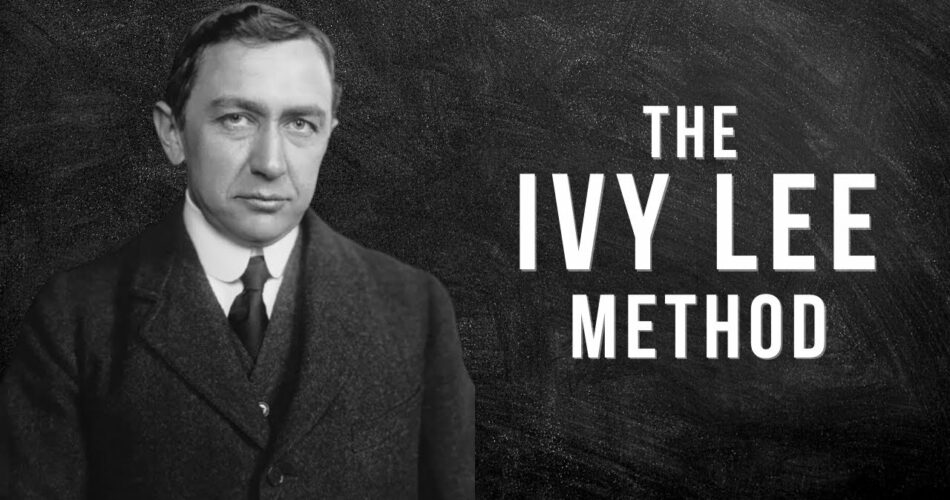The Ivy Lee Method enhances Any.do productivity by focusing on prioritizing six critical daily tasks, reducing decision fatigue. This approach encourages single-tasking and boosts efficiency, transforming task management into a streamlined process.
History of the Ivy Lee Method
This article condenses a conversation from Reddit about the Ivy Lee Method and how it can be used with Any.do to significantly increase productivity.
The Ivy Lee Method has its origins in 1918 when business consultant Ivy Lee introduced this strategy to Charles M. Schwab, the president of Bethlehem Steel Corporation. Schwab was seeking ways to improve his company’s efficiency, and he found Lee’s approach, which was quite simple, to be revolutionary. Each evening, Lee instructed Schwab and his executives to write down six items they thought were important for the next day. The twist was that they had to prioritize those six items in order of importance and then accomplish them one at a time and in that order.
Notable gains were seen in productivity; so much so that he paid consultant Ivy Lee the fee of $25,000 (which would be around $400,000 today) to continue helping him with his operational efficiencies. Schwab saw remarkable improvements in productivity, highlighting the method’s powerful impact on operational efficiency. Lee’s productive output for Schwab was no accident but a marriage of method and clarity. That is, Lee’s method forced poor decision-makers to become better decision-makers and to embrace the single-mindedness necessary for good output.
FactThe original fee of $25,000 paid to Ivy Lee is equivalent to approximately $400,000 today.
This method, which is steeped in history, is well-known for its straightforwardness and efficacy. It became an important strategy for increasing productivity in lots of different places—not just at Bethlehem Steel—very quickly after it was introduced. The common problem of too many worthwhile things to do and too few moments to do them in is something the Ivy Lee Method elegantly addresses.
|
Key Facts |
Details |
|
Year Introduced |
1918 |
|
Introduced By |
Ivy Lee |
|
Initial Client |
Charles M. Schwab, Bethlehem Steel Corporation |
|
Original Fee Paid |
$25,000 (approx. $400,000 today) |
|
Core Principle |
Prioritizing and completing six tasks in order of importance |
|
Notable Outcome |
Significant improvement in company productivity |
Principles of the Ivy Lee Method
As an age-old strategy to boost productivity, the Ivy Lee Method has proven effective enough that many have adopted it. Its foundations lie in teaching individuals how to prioritize both their daily and their longer-term to-do lists. More specifically, the method emphasizes the importance of single-tasking in contrast to our more common mode of multitasking. In this piece, I will first describe the method itself. Then I will relate its backstory and provide an account of how I came to know it. Finally, I will discuss its basic premise of work clarity and offer thoughts on who might benefit from it.
A key tenet of the Ivy Lee Method is reducing distractions and simplifying choices. In this method, you take your tasks and prioritize them down to the six most important items. You can’t do more than that with focus. You have to do less with more focus. And once you’ve worked through those six items, you can either move on to the next day and do the same process again or, if you’re working in some sort of timeframe, just handle these as best you can until you’re done with your work.
TipTry setting aside time each evening to list and prioritize the next day’s tasks to kickstart productivity.
An interesting tale accompanies the method’s success—namely, the tale of Charles Schwab, the president of Bethlehem Steel. According to legend, Schwab paid Lee a princely sum when he saw just how magnificently the method worked. That historical note underlines the method’s efficacy and relevance, even today. Many productivity enthusiasts, including those who advocate for productivity techniques, really dig this method and its impact on managing task lists that are otherwise to be managed in a somewhat chaotic manner.
By planning the task ahead of time, the individual offers themselves a much clearer way to start the next day. There should be no muddiness for the self. It is much easier to become sidetracked when returning to a state of work if there is confusion over what tasks need to be done. The act of planning renders the self clear, and a clear self is a more decent self.
Users of productivity software such as Any.do can reap yet greater rewards from the Ivy Lee Method. With the task management features of Any.do, the user can list the day’s top six priorities, ensuring that the most consequential work gets done. The app’s interface has a way of mimicking the good old-fashioned pen-and-paper task list, and there’s something to be said for that tactile, close-to-the-brain quality of a not-so-distant past. It helps the user to explore the art of task prioritization.
This approach can yield significant increases in productivity. It helps both individuals and teams concentrate on the daily objectives that drive them toward their longer-term goals, and it does this without inviting excessive complexity or stress.
|
Principle |
Description |
|
Prioritize Six Tasks |
Focus on the six most important tasks to enhance focus and efficiency. |
|
Single-Tasking Emphasis |
Avoid multitasking to improve clarity and performance. |
|
Plan Ahead |
Set priorities at the end of the day to provide clear direction for tomorrow. |
|
Minimize Distractions |
Reduce interruptions to maintain concentration on work tasks. |
|
Simplicity Over Complexity |
Simplify choices to avoid overwhelm and boost productivity. |
|
Use of Tool Integration |
Utilize task management software for better prioritization and planning. |
Integrating Ivy Lee with Any.do
The Ivy Lee Method can be integrated into Any.do, which provides a refreshing and compelling approach for those wishing to be more productive. Ivy Lee developed this method in the early 20th century. It is about simplicity and focus. Each day, you prioritize just six critical tasks that you need to get done. If you’re an Any.do user and want to adopt the method, here’s how you can do it seamlessly.
ExampleIf you’re using Any.do, you might create a list named “Ivy Lee Daily Six” to align with Ivy Lee’s prioritization approach.
Start your night by launching Any.do and listing your top six tasks for the next day. This proactive step aligns with the Ivy Lee philosophy of planning ahead to ease morning routines. In Any.do, create a dedicated list named “Ivy Lee Daily Six,” helping to streamline focus toward core tasks. As you catalog tasks, prioritize them based on urgency and significance.
Listing and ordering tasks is only half the battle won. The other half concerns what you do once the tasks are in place. The problem is that not every human is wired for that kind of concentration. And even those who are may not find it easy to accomplish on a given day, with given circumstances. We all have reasons to keep our minds on something other than the single task at hand. Read about why single-tasking is advantageous to reinforce the Ivy Lee Method.
The Ivy Lee Method has as one of its important components the idea of tracking progress. Leverage Any.do’s task completion checkmarks to experience the satisfaction of each job well done. Observing your daily accomplishments can be incredibly motivating, encouraging a consistent drive toward productivity.
Combining the Ivy Lee Method with Any.do has an immediate effect on two things: decision fatigue and focus. These are affected because, with Any.do, you don’t have to decide which tasks need to be done, nor in what order, since the Ivy Lee Method does that for you. And when you just have to focus on the tasks that really matter each day, your degree of freedom to concentrate on them increases substantially.
|
Steps to Integrate Ivy Lee Method with Any.do |
Description |
|
Create a List |
Set up a dedicated list called “Ivy Lee Daily Six” in Any.do. |
|
Prioritize Tasks |
Rank tasks by urgency and significance each night. |
|
Track Progress |
Use checkmarks to track task completion daily. |
|
Focus on Core Tasks |
Concentrate solely on the six prioritized tasks to reduce decision fatigue. |
Benefits for Productivity Software Users
The productivity of users of software tools like Any.do is transformed by the Ivy Lee Method. This is a simple yet effective framework for managing tasks and getting things done. By using this method, a person can minimize decision fatigue—it’s a way to bypass overthinking and to just get on with a set of tasks that have been predefined for the day. And here’s the best part: checking off each of those tasks as they’re completed gives you an immediate sense of accomplishment.
FactThe Ivy Lee Method, which was first advised in 1918, remains a potent tool for student productivity.
The Ivy Lee Method is not limited to making just people in various professions more productive. The organized approach that was suggested to improve task management can likewise benefit students, prospective and current, who are trying to fulfill many and varied demands placed upon them. The Method need not be used as-is but can be adapted to suit the level and number of tasks you must accomplish each day or week. Its basic premise is that at the end of each day, you should have in your possession a list of the six most important tasks you need to accomplish the next day.
If you use productivity software, you can increase the benefits of the Ivy Lee Method by integrating it with a tool like Any.do. The features that Any.do offers as a basic to-do list make it possible to use the Ivy Lee Method effectively. In fact, Any.do is an excellent candidate for pairing with this time management technique since it allows you to rigorously prioritize tasks, align them with their respective deadlines, and manage a multi-layered workload with relative ease—all while adhering to the method’s basic tenets of single-tasking and reduced distraction.
The Ivy Lee Method of productivity, when applied to Any.do, doesn’t just offer a few tips for getting more done—it completely reshapes the way you think about conquering your to-do list and unites your tasks with your higher, long-term goals. To explore more productivity techniques, consider the Pomodoro Method, which can complement the Ivy Lee technique. With this method, you work powerfully and with a revitalized sense of purpose.
|
Feature |
Benefit |
|
Task Prioritization |
Helps users focus on the most important tasks first, reducing decision fatigue. |
|
Deadline Alignment |
Ensures tasks are aligned with their deadlines, improving time management. |
|
Single-tasking |
Promotes focused work by allowing users to concentrate on one task at a time. |
|
Multi-platform Access |
Makes the method portable, allowing users to manage tasks from anywhere, on any device. |
|
Workflow Flexibility |
Adapts to individual workflows, enhancing the user’s personal productivity style. |


